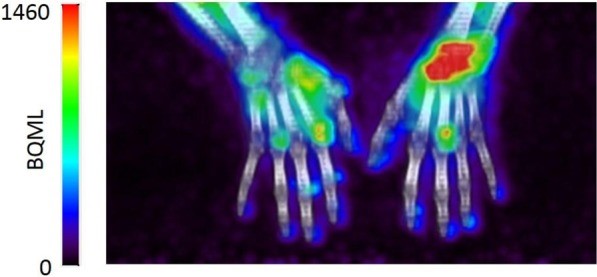Painful joints are common and can lead to a variety of symptoms in patients. The physician can only use approriate tests to diagnose RA when actual swelling of joints occurs. The joint swelling cannot always be seen externally, a blood test is required when RA is suspected. In some cases, a blood test shows that certain anti-rheumatic antibodies are present in the blood that increase the risk of RA. "But only half of the patients with those antibodies in the blood actually develop RA and the other half do not after all. So the blood test is not predictive enough," says Conny van der Laken, rheumatologist at Amsterdam UMC. "It is therefore very important that we improve the diagnosis so that we can treat the patient earlier and thus reduce the severity of the development of the disease. Perhaps this way the disease can even be prevented."
Imaging
Van der Laken is improving an existing diagnostic imaging technique to show inflammation in joints in time. This is important in patients who have painful, but not yet swollen joints, and who also have antibodies against rheumatism in their blood. The imaging technique makes certain immune cells, which play a role in the inflammation, visible in the joints. In one photo session, the device searches the entire body for joint inflammation. With a marker substance it can visualize the inflammation in, for example, hands and wrists, even before it causes further damage to surrounding tissues.
An initial survey shows that the researchers can thus get to it 1 to 2 years earlier before the patient develops RA. This offers opportunities to develop treatments that can prevent further development of RA and thus serious bone and cartilage damage.
 Een voorbeeld van foto’s van de ontwikkelde beeldtechniek waarop de ontstekingen (rood-gele kleuren) in gewrichten van de handen zichtbaar zijn. Bron: Nature: (2020) 10:1047 |
Een voorbeeld van foto’s van de ontwikkelde beeldtechniek waarop de ontstekingen (rood-gele kleuren) in gewrichten van de handen zichtbaar zijn. Bron: Nature: (2020) 10:1047 |
Patient tracking over time
An initial study of 60 patients, who thus experience joint pain and showed a positive blood test for rheumatoid arthritis, has begun. The researchers will follow them for a year. Van der Laken: "Patients find it reassuring that they are followed. We take images of the entire body at the beginning to detect joint inflammation. Then the patients are physically examined every 3 months to check for inflammation. Once the patient develops RA, the study ends and researchers transfer the patient to the rheumatologist for treatment."
Preventive treatment
Once the imaging technology is further optimized, it could detect high-risk patients who are likely to develop rheumatoid arthritis earlier. Van der Laken hopes for rapid and effective treatment for this group over time, so that the patient experiences less disease burden. "We are thinking of a 'reset' of the immune system, which will reduce the inflammation and allow healthy joints to return, and prevent the disease from progressing. After all, RA is a disease of the immune system."
In addition, Van der Laken also wants to prevent unnecessary medication in the group of patients who ultimately turn out not to need it after all because they do not develop rheumatoid arthritis. "So to achieve that, we need to better detect the high-risk group and that's where the imaging technology could help. By the way, there is still plenty of room to include more patients in the study."
Interested in participating? Please contact Conny van der Laken at j.vanderlaken@amsterdamumc.nl or telephone number 020-4443432.
You can find the original (Dutch) interview here.

